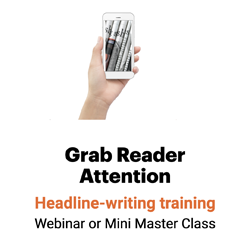9 ways to draw readers in, move them to act

“On average,” said ad man David Ogilvy, “five times as many people read your headline as the body copy. By the time you’ve written your headline, you’ve spent 80 cents of your dollar.”
Call it the 80/20 test: Your headline gets 80% of your audience members’ attention; the rest of your message the other 20%.
So how can you get 80% of the ROI on your message from your headline? Here are nine ways:
1. Think Like a Reader.
I once worked with a client on an article about customer service. The head:
Be A Customer Champion. Be Elite
About 250 words in — in an oh-by-the-way aside — the article mentioned that winners would get an all-expenses-paid trip to Vegas.
Here’s a winning marketing strategy: Giving away a trip to Vegas, a drone or an Apple watch? Mention that in the headline.
Here’s the rewrite:
Win a trip for two to Las Vegas
ABC customer service program honors XYZ
2. Call out to readers.
“If you want mothers to read … display ‘Mothers’ in your headline,” advised advertising guru David Ogilvy.
So call out to readers. Write headlines that start with IT managers, Business owners or Nurses, for example. I love this one, from Workers Compensation Board-Alberta:
Case managers: There’s an app for that!
Injured workers can now get claims updates on their phones
3. Use this headline formula.
Want to boost click through rates, engagement and sales? Here’s a simple formula to try for writing a great headline:
Write about your greatest benefit for your reader’s greatest need.
For communicators, that might be:
Sail through the approval process and go home early.
For semiconductor engineers, that might be:
Move from concept to simulation to prototype with a few keystrokes.
For gamers, that might be:
Level up your character to 85.
4. Focus on benefits, not features.
“Would you rather read a letter labeled ‘Dues Notice’?” asks Jeffrey Gitomer, principal of BuyGitomer Inc. Or one with the headline, “Build your business and boost your bottom line next year”?
Your conference isn’t a benefit. Your product isn’t a benefit. Neither are your services, programs or ideas.
What those things will do for the reader is the benefit.
Instead of:
Women’s Health Conference
Make it:
Revitalize your sexuality and justify your chocolate obsession
Instead of:
XYZ Company announces new disability insurance
Make it:
Get back to work faster with ITT Hartford’s new Ability Assurance
Instead of:
XYZ Company announces new product
Make it:
Grow bigger, lusher plants — and never have to water again — with XYZ’s SuperPlantGro
“It’s not about what you do,” writes Alan Weiss, consultant and principal of Summit Consulting. “It’s about what I can do after you’re done.”
Readers love benefits, because they focus on readers’ favorite topic: themselves. So don’t be afraid to layer on the benefits. Recreational Products Insurance published a brochure for agents with this head and deck:
Rev Up Your Sales
Launch more business with more products
Subheads continued to ladle on the benefits:
Crank up volume
Drive in profits
Collect a bonus
5. Use power words.
Benefits are verbs, not nouns. So to write effective headlines, focus on benefits-oriented verbs and verb phrases. Here are some to get you started:
Benefits for catchy headlines |
||
|
|
|
These work for content marketing, digital marketing, email marketing, subject lines — even LinkedIn headlines and ad headlines.
So instead of:
New webinar helps managers improve productivity
Try:
Get all your work done in half the time, be the office hero, and go home early
(The latter, by the way, is one of my favorite marketing headlines of all time.)
6. Quantify and specify benefits.
While reviewing a marketing post for a client recently, I came across this headline:
Reap many rewards.
Well … that’s a little broad. It’s not very interesting, because it’s not visual. It begs credibility, because it sounds like the communicator couldn’t come up with any real benefits. And it could apply to virtually any product from virtually any company in virtually any industry.
If your benefits statements are too broad, they’ll come off sounding generic and meaningless. To make your message more concrete, compelling and credible, quantify and specify your benefits.
A participant in one of my writing workshops was working on a brochure to convince customers to move from paper statements to electronic ones. His first headline:
Save the environment with paperless statements.
I want to believe. But the benefit is so over-the-top, I just can’t. So I asked him to specify his benefit statement with a tangible, true detail. His rewrite:
Save half a tree a year with paperless statements.
One way to make your benefit more concrete is to add a numeral. Woman’s Touch Mammopad communicators, for instance, went for this broad — and to some women, somewhat discomforting — message in a brochure:
Discover the comfort of a softer mammogram. … Mammopad is like adding a woman’s touch to the procedure itself.
And the communicators buried this quantifiable detail at the bottom of the message:
Three out of four women reported a reduction in discomfort of nearly 50%.
So how about a headline like:
How would you like your next mammogram to be 50% more comfortable?
Hey, I’m happy with an asterisk to mousetype legalese if it allows me to write a quantifiable benefit.
Notice how quantifying and specifying make this envelope teaser for the World Wildlife Fund more powerful:
Every day an estimated 800 dolphins, porpoises and whales will die …
… unless you act now
Yikes! I’m writing a check before I’ve opened the envelope!
The more you know about your products and services, the more specific you can be. So drill down. Study the spec sheets. Ask questions.
Learn enough about the people, places and things you’re promoting to quantify and specify.
7. Add a numeral.
Speaking of numerals …
Next time you hit the Safeway, take a look at the magazines displayed at the checkout counter. Chances are, you’ll find that they’re packed with numerals.
There’s a good reason for that: Headlines with numerals, like Top 10, promise quantifiable value. And that draws readers. “Numbers sell,” writes Richard Riccelli, president of Post Rd, Inc.
Whether you’re writing a tipsheet or service story, a blog post or a marketing piece, add a numeral to the headline. That will increase your message’s chance of getting opened, read and shared.
Add numerals online. Numerals are power tools that get:
- Shared in social media. Articles with numerals in their headline tend to be shared more on Facebook than stories without digits, according to research by viral marketing scientist Dan Zarrella.
- Engagement on blogs. My year-end roundup posts of PRSA’s Issues & Trends blog always score Nos. 1 or 2 for the year, according to editor John Elsasser. That’s because they include numerals, like “7 writing tips for the New Year.”
- Attention on webpages. Numerals are more scannable, according to usability expert Jakob Nielsen. And they deliver tangible facts, which is what web visitors seek online.
- Readership of releases. News releases with numerals in the headline performed better than those without, according to a study by PR Newswire.
- Opened in email. EmailLabs ran a split test of these three subject lines:
Using Link Click-Through Tracking to Segment Your List
3 Tips to Improve Your Newsletter’s ROI
Build Your List Through “Piggy-Back Marketing”
The subject line promising “3 Tips” produced both higher open and click-through rates than the other two.
Select the right numbers: To choose the best numerals for your headlines:
- Favor odd numbers. Oddly, odd numbers sell better than even ones, according to Folio: So 7 Steps may be more effective than 10 Tips.
- Choose specific numbers. “101 or 99 work better than 100,” Riccelli writes. “65 is better than 75.” 59 seconds is more specific than one minute, for instance.
- Better yet, make it 7. That number seems to appeal to readers. The number 13, on the other hand, does not.
- Don’t overwhelm readers. I’m not looking for “66 steps to 6-pack abs.” “Saying ‘35 best exercises’ is too many,” Men’s Health editor Dave Zinczenko told The New York Times. “But ‘789 great new tips for summer’ is fine. That says value without saying work.”
- But don’t underwhelm readers, either. Posts with headlines promoting seven or more items outperformed those with six or fewer, according to an internal study of HubSpot’s blog. While HubSpot still posts pieces with six or fewer items, writes Pamela Vaughan, HubSpot’s lead blog strategist, the inbound marketing experts don’t promote that quantity in the headline.
- Avoid numbers for serious subjects. “14 ways to deal with breast cancer,” for instance, sounds flip.
So instead of:
Increase profits
Take a tip from Ann Bloch, principal of Ann Bloch Communications, and try something like:
Do 3 things you hate … and watch your income double
Or steal a trick from the tabloids with something like:
Lose 7 pounds a week without drugs or a diet
8. Develop a vignette.
Keynote speaker Tom Antion suggests:
Speaking puts me in a higher tax bracket
Maybe it can do the same for you
9. Get found by search engines.
At Wylie Communications, we use SEMRush to help us find the right search terms.
And we use SEMRush’s SEO Writing Assistant for Google docs for help writing pages and posts. It includes help for headline writing, as well.
SEMRush has helped us boost our search results. We think it can help you, too. (We are not affiliated with SEMRush; we share it just because we like it.)
How to write a good headline
Ready to write? Here’s a quick checklist to run on your marketing headline. Does your headline:
- Think Like a Reader? Does it focus on what readers want, not what you want from readers?
- Call out to the reader? Have you started with IT managers, Business owners or Nurses, for instance?
- Use a proven headline formula? Are you writing about your greatest benefit for your reader’s greatest need?
- Focus on benefits, not features? Does it cover what readers can do with your Whatsit, not on your Whatsit itself?
- Use power words? Do you use verbs and verb phrases like Make money, Save time, Avoid effort?
- Quantify and specify your benefits? Are they tangible and credible instead of generic and meaningless?
- Include a numeral? Do you demonstrate the quantifiable value you deliver in your message?
- Draw readers in with a vignette? Do you show how great readers’ lives could be with your services?
- Include searchable elements? Did you use online tools to make sure your headline is optimized for search engines?
If so, it’s time to press Send.
Keep building your skills
Check out these resources for improving your headlines and marketing messages:
- How to write a good headline: Make the most of the first element readers see
- How to write a press release headline: 57% of news audiences read little else
- How to craft persuasive writing: Grab readers’ attention and move them to act
- Polish your skills with writing workshops: Learn headline writing, marketing writing & more
- Get better every day: Join our members-only training and coaching site

Leave a Reply